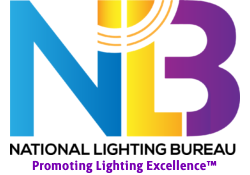The High-Benefit Lighting® Awards Program is unique. Established by the National Lighting Bureau in 1980, the program recognizes lighting achievements that demonstrate lighting’s ability to enhance human performance and well-being; i.e., to provide High-Benefit Lighting.
An Unusual Reward
Submissions to the program are brief descriptions of lighting projects and the benefits they provide (see entry form). Everyone who enters receives a hand-inscribed certificate of participation. But those who submit information about particularly noteworthy projects receive much more, by working directly with the National Lighting Bureau staff to develop a comprehensive case history that is published in one or more national trade or professional journals.
The submitter provides the facts and is recognized as the bylined author of the article. The Bureau’s staff handles all the writing and discussions with editors; nothing is submitted for publication without the bylined author’s 100-percent approval. Being the bylined author of an article appearing in a well-known and highly respected periodical is surely not a typical prize; the national recognition it brings can be a source of great satisfaction.
All entrants will be promptly informed if their submissions are being considered for further development. You will be sent a letter accompanied by a sampling of articles published in the past, along with a variety of other materials.
Ensuring a Win
The Bureau is particularly interested in case histories that emphasize the bottom-line benefits of lighting. Typical of these are submissions that demonstrate how new or modernized lighting:
- Increased employee productivity so that more could be done in the same amount of time, or the same amount of work could be done in less time.
- Increased retail sales by attracting more people to a store or shopping center, and/or by making displays more attractive or noticeable.
- Permitted better quality control, thereby improving a finished product and reducing the waste associated with having to do work over.
- Improved safety and security, thereby reducing vandalism or eliminating assaults and break-ins and possibly even lowering insurance rates.
- Reduced vehicle-vehicle, vehicle-pedestrian, and other types of accidents.
- Lowered exposure to legal liability.
- Permitted multi-purpose use of space (space was used for more than one purpose).
In each of these and many other instances, the benefits involved can be translated into dollars and cents. For example, if new lighting helps 50 office or plant employees work just two-percent faster, the bottom-line benefit could be several thousand dollars annually.
For a submission to be developed into an article, such benefits must be documentable, either through collected data or through the considered opinions of individuals with first-hand knowledge of how better illumination has been of value to them and the operations for which they are responsible.
The High-Benefit Lighting Awards Program is not a design competition. Case histories do not have to illustrate new or innovative techniques. They merely must demonstrate that good lighting can help pay for itself by generating bottom-line benefits in addition to energy savings alone.
The Program’s Purpose
The National Lighting Bureau is a not-for-profit educational organization sponsored by trade associations, professional societies, lighting-system and system-components manufacturers, unions, utilities, and agencies of the federal government. Its principal purpose is informing people of the benefits they can derive by improving the effectiveness of their lighting systems in offices, stores, factories, warehouses, schools, and hospitals; just about anywhere that lighting is or can be used, outside or inside.
Relating information about the kinds of benefits people have actually derived is one of the most effective ways of educating them about the value of High-Benefit Lighting. Citing the dollars saved as a result of more productive workers, fewer accidents, more retail sales, and so on reinforces the concept that High-Benefit Lighting can be so cost-effective that plans for new systems or modernization of existing ones should be designed to achieve optimum bottom-line benefits.
Without such awareness, the primary emphasis might be on energy savings alone. When this happens, the quality needed to establish the other, often far more valuable, bottom-line benefits might be ignored.
Eligibility for Submitting an Entry
Just about anyone associated with a specific project is eligible to submit an entry. This includes owners of the space, the person who designed the system, the contractor who installed it, or representatives of the utility serving the system.
Application
Click here for an application.
